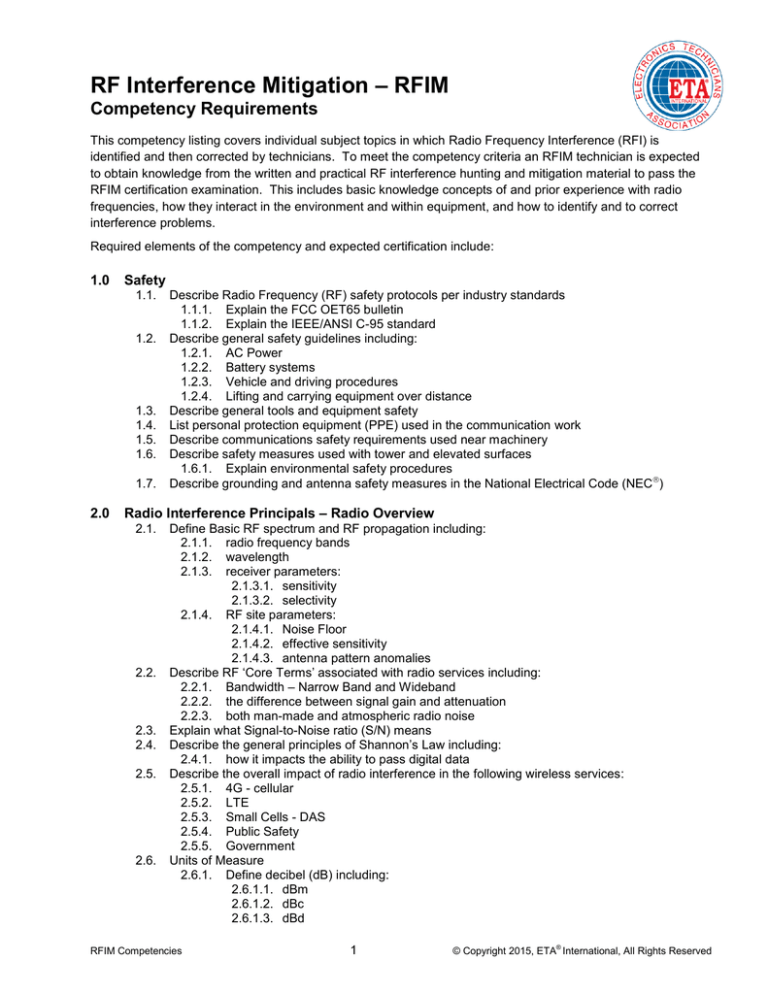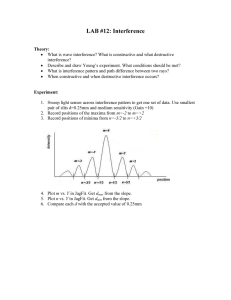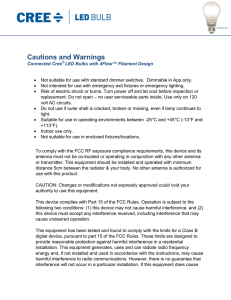
RF Interference Mitigation – RFIM
Competency Requirements
This competency listing covers individual subject topics in which Radio Frequency Interference (RFI) is
identified and then corrected by technicians. To meet the competency criteria an RFIM technician is expected
to obtain knowledge from the written and practical RF interference hunting and mitigation material to pass the
RFIM certification examination. This includes basic knowledge concepts of and prior experience with radio
frequencies, how they interact in the environment and within equipment, and how to identify and to correct
interference problems.
Required elements of the competency and expected certification include:
1.0
Safety
1.1.
1.2.
1.3.
1.4.
1.5.
1.6.
1.7.
2.0
Describe Radio Frequency (RF) safety protocols per industry standards
1.1.1. Explain the FCC OET65 bulletin
1.1.2. Explain the IEEE/ANSI C-95 standard
Describe general safety guidelines including:
1.2.1. AC Power
1.2.2. Battery systems
1.2.3. Vehicle and driving procedures
1.2.4. Lifting and carrying equipment over distance
Describe general tools and equipment safety
List personal protection equipment (PPE) used in the communication work
Describe communications safety requirements used near machinery
Describe safety measures used with tower and elevated surfaces
1.6.1. Explain environmental safety procedures
Describe grounding and antenna safety measures in the National Electrical Code (NEC )
Radio Interference Principals – Radio Overview
2.1.
2.2.
2.3.
2.4.
2.5.
2.6.
Define Basic RF spectrum and RF propagation including:
2.1.1. radio frequency bands
2.1.2. wavelength
2.1.3. receiver parameters:
2.1.3.1. sensitivity
2.1.3.2. selectivity
2.1.4. RF site parameters:
2.1.4.1. Noise Floor
2.1.4.2. effective sensitivity
2.1.4.3. antenna pattern anomalies
Describe RF ‘Core Terms’ associated with radio services including:
2.2.1. Bandwidth – Narrow Band and Wideband
2.2.2. the difference between signal gain and attenuation
2.2.3. both man-made and atmospheric radio noise
Explain what Signal-to-Noise ratio (S/N) means
Describe the general principles of Shannon’s Law including:
2.4.1. how it impacts the ability to pass digital data
Describe the overall impact of radio interference in the following wireless services:
2.5.1. 4G - cellular
2.5.2. LTE
2.5.3. Small Cells - DAS
2.5.4. Public Safety
2.5.5. Government
Units of Measure
2.6.1. Define decibel (dB) including:
2.6.1.1. dBm
2.6.1.2. dBc
2.6.1.3. dBd
RFIM Competencies
1
© Copyright 2015, ETA® International, All Rights Reserved
Radio Frequency Interference Mitigation Knowledge Competencies
2.6.1.4. dBi
2.6.2. Describe the difference between dB and dBm
2.6.3. Describe dBm and dBc and how they are related to each other
2.6.4. Explain the importance of accuracy when using units of measure
2.6.5. Describe how units of power in Watts and dBm are related
2.7. Explain the formula and factors that are part of Free Space Loss
2.8. Describe how an antenna can have gain
2.8.1. Describe the difference between dBd and dBi when referring to antenna gain
2.9. Describe what Rayleigh Fading is and how it affects radio signals
2.10. Define multipath radio signals and MIMO Technology (Multiple Input Multiple Output)
2.11. Describe the large amount of RF energy carried over a very broad spectrum in CATV networks
2.11.1. Describe the CATV network shields protecting the analog and/or digital carriers
2.11.2. Describe RF Interference resulting from disturbed or damaged shields
2.12. Describe how an ISO-Tee adapter is built and how it should be used to test for effective sensitivity
3.0
Interference Types – Overview and Corrective Actions
3.1.
3.2.
3.3.
Define the meaning of radio interference
Describe the difference between radio noise and radio interference
Describe each of the following interference types:
3.3.1. Co-channel Interference
3.3.2. Adjacent Channel Interference
3.3.3. External spurious noise
3.3.4. Sideband noise
3.3.5. Spurious Response
3.3.6. Harmonics, sub-harmonics and multiples of harmonics
3.3.7. Electrical and power line noise
3.3.8. Image interference
3.3.9. Lamp interference
3.3.9.1. Fluorescent and CFL (Compact FL) lamps
3.3.9.2. Tower lamps
3.3.10. Antenna separation and spacing
3.3.11. RF attenuation by non-electrical objects
3.3.12. RF interference upon non-radio apparatus
3.4. Describe each of the prior interference types impact on radio or communications performance
3.5. Describe the steps to mitigate each of the prior interference types including:
3.5.1. correcting the source
3.5.2. capacitor use
3.5.3. use of chokes
3.5.4. ferrite beads use
3.6. Describe how to mitigate multipath RF interference
3.6.1. Explain the differences between narrowband noise-interference and wideband
noise-interference
3.7. Describe radio components thought to cause radio interference including:
3.7.1. lightning protectors
3.7.2. components hit by lightning
3.8. Define radio receiver desense; also known as blocking
3.8.1. Describe the role this kind of radio interference plays in receiver performance
3.9. Explain the role radio interference plays in receiver performance
3.10. Describe the following radio interference indicators:
3.10.1. Receiver threshold
3.10.2. Transmitter spurious carriers
3.10.3. Transmitter isolation – power
4.0
Intermodulation
4.1.
4.2.
Define Intermodulation when involving radio signals
Describe how Intermodulation is created including:
4.2.1. internal intermodulation
4.2.2. external intermodulation
RFIM Competencies
2
© Copyright 2015, ETA® International, All Rights Reserved
Radio Frequency Interference Mitigation Knowledge Competencies
4.3. Describe Passive Intermodulation (PIM) including:
4.3.1. the causes of PIM
4.3.2. which piece(s) of radio equipment a high PIM level most affects and define its impact
4.3.3. the IEC-62037 standard
4.4. Describe how PIM testing in general is conducted and sources of PIM including:
4.4.1. the term “2 X 20 Watts” when referring to PIM testing
4.4.2. the function of a PIM tester
4.4.3. the components required of all PIM testers
4.4.4. what is measured on the receive side of a PIM test
4.4.5. how to convert dBm to dBc during a PIM test
4.4.6. the effects of high PIM levels on radio receiver quality and performance
5.0
Filters – Filter Systems Usage to Mitigate RFI
5.1.
5.2.
Define what the term filter (cavity) means when used in radio systems
Describe how a filter is constructed and tuned for various frequencies
5.2.1. Describe how environmental factors affect tuned filters
5.3. Explain why filter physical size is connected to the frequency of operation
5.4. Describe the following types of radio filters:
5.4.1. Bandpass filter
5.4.2. Band Reject or Notch filter
5.4.3. Low pass filter
5.4.4. High pass filter
5.4.5. Crystal filters
5.5. Define the purpose of and common uses of a harmonic filter
5.6. Describe the purpose of a pre-select filter
5.7. Describe what a circulator and isolator are in a radio antenna system
5.8. Describe the following concerning radio duplexers including:
5.8.1. components of most radio duplexers
5.8.2. purpose of a radio duplexer
5.8.3. “insertion loss” meaning when dealing with a duplexer
5.8.4. “critical cable lengths” meaning when dealing with radio duplexers
5.9. Define what transmitter combiners are
5.9.1. Explain the use of a transmitter combiner
5.9.2. Describe the benefit to the radio location or site when using a transmitter combiner
5.9.3. Describe how isolators are used in transmitter combiners
5.10. Describe receiver pre-amplifiers and multi-couplers including:
5.10.1. pre-amplifiers and multi-couplers used in radio systems
5.10.2. the multi-coupled receiver system antenna typically located on the tower
5.10.3. the gain of the receiver pre-amplifier
5.10.4. how noise and interference play a role in receiver systems
5.11. Describe a tower mounted amplifier (TMA) including:
5.11.1. why TMA’s are used in radio networks
5.11.2. how TMA’s are powered
5.11.3. how a TMA can contribute to site noise, interference and intermodulation
5.12. Describe how to tune and verify RF filters using a tracking generator
6.0
Test Equipment For Interference Hunting
6.1.
6.2.
Describe how the following are used to find and define radio interference:
6.1.1. Spectrum Analyzers (SA)
6.1.2. Field Strength meters
6.1.3. Doppler antennas
6.1.4. Directional antennas
6.1.5. Omnidirectional antennas
6.1.6. Signal-sniffers
Describe how each of the above are used to identify good signals versus bad including:
6.2.1. the basic operation of a Spectrum Analyzer (SA)
6.2.2. the added value provided by a direction-finding or directional antenna
6.2.3. when a simple signal-sniffer would be used to find interference
6.2.4. dynamic range limitations
RFIM Competencies
3
© Copyright 2015, ETA® International, All Rights Reserved
Radio Frequency Interference Mitigation Knowledge Competencies
6.3.
6.4.
7.0
Finding Interference
7.1.
7.2.
7.3.
7.4.
8.0
Explain why a monitor receiver or Spectrum Analyzer (SA) is considered the most important tool
for finding RFI
Describe how to document interference
6.4.1. Describe what is a screen or trace
6.4.2. Describe how mapping capability helps to identify interference sources and locations
6.4.3. Explain important measurement considerations when documenting radio interference
Describe the process for finding broadband spurious radio signals
Describe how to assemble test equipment and begin the process for locating frequency specific
interference
Describe how a Yagi antenna and good test cable can be used for finding radio interference
directions using triangulation
Describe how a Doppler based antenna system creates accuracy when looking for radio
interference
Interpreting Test Results – Corrective Actions
8.1. Describe how to best interpret a Spectrum Analyzer (SA) result as follows:
8.1.1. Measurement of the noise floor
8.1.2. Define Occupied Channel Bandwidth (OBW) measurement
8.1.2.1. Using OBW, describe how much bandwidth the interference is creating
8.1.3. Define the “Using the Reference Level” to identify the magnitude of the interfering
signal
8.1.4. Describe the use of markers to identify specific frequencies and levels
8.1.5. Identify the following:
8.1.5.1. a legitimate signal versus an unwanted signal
8.1.5.2. an unwanted – interfering radio signal
8.1.6. Describe how to pinpoint the undesired signal in magnitude and direction
8.2. Describe how to contact the FCC concerning interference
8.2.1. Describe how to document and keep an FCC/NTIA log(s)
8.2.2. Describe what must be prepared for an FCC inspection
8.2.3. Describe the procedures for NTIA Interfacing
End of RF Interference Mitigation Competencies
Find An ETA Approved School and/or Test Site:
RFIM Competencies
4
http://www.eta-i.org/test_sites.html
© Copyright 2015, ETA® International, All Rights Reserved
Radio Frequency Interference Mitigation Knowledge Competencies
Suggested Additional Study Material and Resources:
Useful articles, white papers and videos can be found at the following web sites:
www.doverts.com, and http://iwiesenfel.wix.com/iwa#!, and www.radio-electronics.com, or by
®
contacting ETA International for other additional resources
Radio Frequency Interference from A to Z; Ira Wiesenfeld, P.E., Thomas K. Dover, Jay Thompson;
ISBN: 978-0-9915913-4-3; Self-published; 2015; pp. 218; $80; Available through ETA 800-2883824, www.eta-i.org or through http://iwiesenfel.wix.com/iwa#!
Radio Frequency Interference & Mitigation; Thomas K. Dover; ISBN: 978-1-9400429-89-2; DTS,inc.;
2015; pp. 150; Available through www.doverts.com
Wiring for Wireless Sites; Ira Wiesenfeld, P.E.; ISBN 978-1401810375; Thompson Delmar Learning;
2002; pp. 260; Available through http://iwiesenfel.wix.com/iwa#!
Practical Antenna Handbook, 5E; Joseph Carr & George (Bud) W. Hippisley; ISBN 978-0071639583;
McGraw-Hill/Tab Electronics; 2011; pp.784
Modern Electronic Communication, 9E; Jeff Beasley & Gary M. Miller; ISBN 978-0132251136;
Prentice Hall; 2007; pp.992
Handbook of Radio & Wireless Technology; Sam Gibilisco; ISBN 978-0070230248; McGraw-Hill
Professional; 2008; pp.640
Basic Radio, Principles & Technology; Ian Poole; ISBN 978-0750626323; Newnes; 1998; pp.224
RFI - Certification Program Subject Matter Advisory Board:
Tom Dover
Jay Thompson, CETsr
Ira M. Wiesenfeld, P.E., CETsr
Don Huston, SIT
Merle Taylor, RFIM
J. Joe Goudy, CETsr, FOT-OSP
DTS, Inc.; (UT)
IWA & Assoc.; (IN)
IWA & Assoc.; (TX)
Bird Technologies; (OH)
Rockinmesquite Consulting, (TX)
Indian Hills C.C. (IA)
tom@doverts.com
jay@tcsd.com
iwiesenfel@aol.com
dhuston@birdrf.com
merle@rockinmesquite.com
jgoudy@lisco.com
ETA certification programs are accredited through the ICAC,
complying with the ISO/IEC 17024 standard.
RFIM Competencies
5
© Copyright 2015, ETA® International, All Rights Reserved





